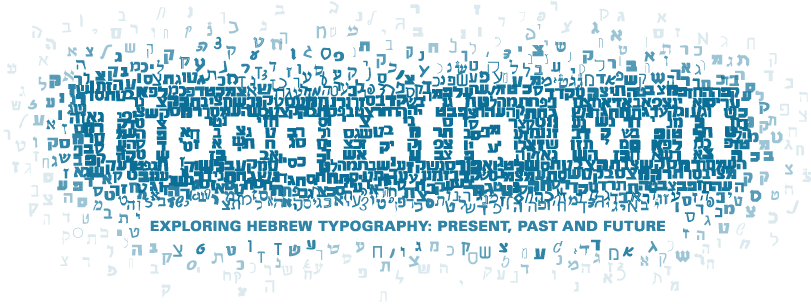Thursday, February 25, 2010
Dan Reisinger
Throughout his admirable career, Reisinger has dealt with many different aspects of design and culture; political, social and cultural posters, monuments for Yad Vashem- the Holocaust Museum in Jerusalem, logos for El Al airlines, Tel Aviv Museum of Art, Habima national theater, various stamps for the state of Israel, medals of honor for Israel's Defence Forces, and much more...
Tuesday, February 16, 2010
Adi Stern
 Israel Festival, Jerusalem Logo, 1994
Israel Festival, Jerusalem Logo, 1994 Virus, Bat Sheva dance company, poster
Virus, Bat Sheva dance company, posterMonday, February 15, 2010
Oded Ezer
He is already world known; the single contemporary israeli typographer (or typographic artists) to become a design pop star. Oded Ezer’s experiments are innovative and inspiring, twisting the boundaries and exploring the possibilities of meshing the field of Hebrew type (as well as Latin) with biology, technology, materiality and endless more alternatives.

History of Jewish Hebrew Printing
The Jewish Encyclopedia's Typography entry:
Saturday, February 13, 2010
David Tartakover
To show his support and contribute to a protest movement (that called prime minister Menahem Begin to begin a peace process, in 1978), Tartakover voluntarily designed a poster with the title "Peace Now". The title became the movement's name and was made into the first political sticker in Israel, which is effective till this day.
The logo originated in the poster Tartakover designed for the 30th anniversary of the state of Israel, in which the word "Peace" is set in the biblical Koren font (designed by Eliahu Koren in the 1950's as a revival of Spanish-Italian Hebrew type from 1800's) with blue skies in the background. According to Tartakover, the innovation in the Peace Now logo was the combination of the two typefaces - "peace" set in the traditional Koren and "now" set in the headline-style Haim, explicitly secular Israeli. the contrasting combination gave the logo its presence and memorability.
Friday, February 12, 2010
Oldies Collections
 collection of the letter Aleph (first in the Hebrew alphabet), 1900-1950's
collection of the letter Aleph (first in the Hebrew alphabet), 1900-1950'shttp://www.flickr.com/photos/isotype75/
 Sonol's Road Map
Sonol's Road Maphttp://www.flickr.com/photos/safta/
 Immigration, Absorption, Settlement Stamp
Immigration, Absorption, Settlement Stamphttp://www.flickr.com/photos/karenhorton/
Tuesday, February 9, 2010
Fontef
Fontef (Yontef's one man type foundry) has a well-designed website (both in Hebrew and English versions) that showcase his great designs. Notice his bilingual families such as Pauza - the latin font has some of the harsh geometries taken from hebrew while the hebrew font has some more roundness at the corners of the letter; both typefaces balance out each other and potentially allow to a good combination of English and Hebrew text.
Monday, February 8, 2010
Hebrew in Motion
Fortis/At Lo Tova Elay (you're no good to me)
I love Rami Fortis (awesome israeli musician for the past 30 years). I thinks this does a good job with the "vibe" of the song. the animation has a good beat, usage of a variety of fonts, although a few are quite "weird" (ugly), i see how mixing the fonts together portrays some "Punkiness" which Fortis has so much of.
The Apples/Ze Ra'ayon Tov (thats a good idea)
Again, The Apples - awesome Israeli band. I like the use of an older-looking font, to mach the sample of an old record in the song. I believe the main font is Palestina, Oded Ezer's typeface for Hagilda.
Hachamishia Hakamerit/Bo (come on)
One of my favorite skits from the Israeli comedy tv show Hachamishia Hakamerit, in which different army officers regurgitate different familier speeches calling on men to join the army. Nice emphasis on different font and color for each voice, which leads to the chaos of type and sound (and message).
Hagilda - Independant Type Design Cooperative
Hagilda (The Guild) is an Israeli type foundry (or as they like to define themselves- type design cooperative) of prominent designers Michal Sahar and Danny Meirav, both Bezalel graduates from the late 90’s and each runs his/her own independant design studio.
Almost all of their font families are revivals of known Hebrew typefaces (such as Haim, Aharoni, Meriam) which have become default to us israeli Microsoft Word users (the equivalent to times new roman, if i may say so myself). Hagilda brings the joy back to older Hebrew typography and makes me, at least, pay more attention to the minutiae in such ancestors. Another aspect they express is vernacular or signage inspired typography, such as the poppy and fun Glass of Milk and Kartiv (Popsicle). Looking through the catalog really gives you a sense of the design culture, and therefore popular culture, that developed in the short history of Israel.























